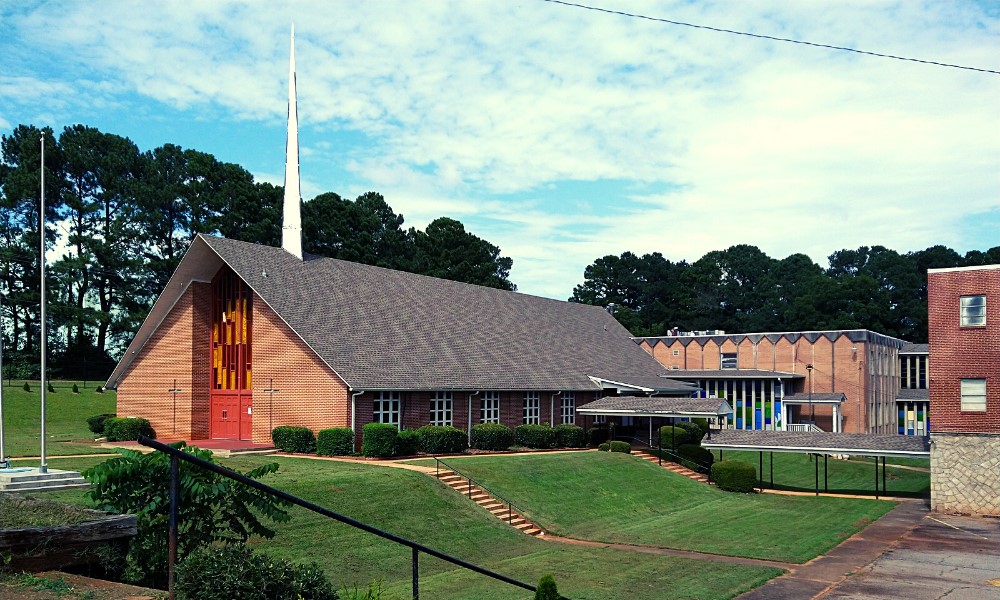History of DeKalb Medicine, 1830-1930; pt II
By Melissa Swindell, Collections Coordinator
This article covers the history of medicine in DeKalb from the 1830s to the early part of the 20th century.
After the 1830s cholera epidemic, the public began losing trust in physicians. During the epidemic, university trained physicians used bloodletting and purging to cure patients, but this often produced the opposite result. By the mid-19th century, people started turning to eclectic healers, who used non-invasive techniques and plant-based remedies.
One such healer in Decatur in 1837 was Dr. Major Ra who lived on “the Atlanta Rd.” Dr. Ra had a lobelia patch near his home,” which was used to treat respiratory diseases such as asthma, bronchitis, pneumonia, and coughing. However, in large doses lobelia can cause severe side effects from nausea to convulsions and even induce a coma 1. One afternoon, Preacher Singleton’s wife went out near the Atlanta road to gathered some greens. She wondered onto Dr. Ra’s patch of land where the lobelia plants formerly grew. When she became sick, Dr. Calhoun was called, and he stated the cause of death as lobelia.”
By the 1840s, plant-based healing was relatively common, and almost “anyone was free to practice [healing]”2 since most states in the US had abolished the requirements for “Physician licensing” by this time. Within Georgia 16 medical colleges, many botanico-medical and eclectic medicine schools opened and eventually merged or closed during the second half of the 19th century. “Scientific medicine was rapidly being replaced by pseudo-sciences such as hydropathy, phrenology, mesmerism, and patent medicines, often over-the-counter commercial products that were marketed without regard to effectiveness.”3 This became a growing concern for university trained and licensed physicians who came together between 1845 and 1847.
“On May 7, 1847, 250 physicians from 22 states – representing 40 medical societies and 28 colleges – met at the Academy of Natural Sciences in Philadelphia.”4 Just half a mile from the College of Physicians where you’ll remember founding father, Dr. Benjamin Rush studied and practiced a century earlier. This group formed the American Medical Association with the goal of advancing scientific standards for medical education and “launching a program for medical ethics and improved public health.” 5
Meanwhile, across the pond, in Europe, French chemist Louis Pasteur was working on scientifically-based experiments that would give rise to his germ theory. “The theory that certain diseases are caused by the invasion of the body by microorganisms.”6 Despite these unique advances in medical practice and theory, “the proliferation of commercial medical schools [in the US, continued to] contribute to low standards throughout the whole profession. As a result, American physicians had little appreciation for pure science.
Intensely pragmatic in their interests, they regarded the germ theory of disease as inconsequential because it offered no quick therapeutic returns.”7 Continuing in this vein (pun intended) for the next decade, the pseudo-science medical community and its followers were eventually “forced to systematically study the cause of disease and infection.”8 Following the Civil War “two-thirds of the approximately six hundred and 60 thousand deaths of soldiers were caused by uncontrolled infectious diseases.” 9
As the United States was awakening to this realization, British surgeon Joseph Lister was experimenting with Pasteur’s theory that microorganisms cause infection. Lister observed that that 45-50% of amputation patients typically died from sepsis. Once he began using an antiseptic during surgeries it resulted in a reduced mortality rate of 15%. 10 Despite the advances in medical science abroad, the United States was slow to accept change.
A decade after the Civil War, Dr. John Hamilton Goss, who had served Prof. of Diseases of Women and Children at the Georgia Eclectic Medial College in Atlanta, began practicing in Decatur. Dr. Goss built the first brick residence in Decatur on Church St. He had a little detached office building on a corner of his residence lot. Before Decatur had a dentist, he extracted teeth for his patients as a routine matter.
Two years later, in 1877, Dr. George Newton Flowers graduated from Nashville Medical College. Dr. Flowers, originally from DeKalb Co. returned to practice here. Unlike most other doctors, however, he was also the long-time postmaster at Doraville, and operated a mercantile business there. Like most other doctors of this period he rode horseback and compounded his own prescriptions and made his own preparations from herbs.
Finally, by the 1880s scientific inquiry began to reenter the medical community. Across the country, in Rochester, Minnesota, “Surgeon Dr. William Mayo began practicing antiseptic surgery … and won converts among colleagues. These studies in the scientific basis of disease combined with improved medical education to make “scientific medicine” the predominate philosophy by the end of the century. Alternative medicine was still practiced, but was often combined with scientific medical principles.”11
For instance, around the same time during the 1880s, the drug Vapo-Cresolene came on the market. “The device used Cresolene, a coal-tar byproduct in liquid form that was vaporized over a small lamp lit with kerosene.” 12 The manufacturer marketed it as a germicide with “powerful germ-destroying properties,”13 playing to the public’s renewed beliefs in medical science. “The company claimed that inhaling the fumes would cure numerous respiratory diseases, including pneumonia, whooping cough and diphtheria.”14 It took over 25 years for the American Medical Association to debunk these claims, and despite this Vapo-Cresolene continued to be sold into the 1950s.15
Six years after Vapo-Cresolene was on the market, Atlanta pharmacist John S. Pemberton of the Pemberton Chemical Company created his most famous patent medicine, a tonic that he claimed would “cure headaches, upset stomach, and fatigue.”16 Today, we know this drink as Coca-Cola, with its name stemming from its former main ingredients: cocaine and the caffeine-rich kola nut. 17
A few years after Pemberton sold Coca-Cola to Jacob’s Pharmacy for distribution in Atlanta, Wiley Shorter Ansley would work there part-time while he studying at the Atlanta College of Pharmacy. Dr. Ansley went on to work in pharmacies in Atlanta and Lithonia. He eventually attended the Atlanta College of Physicians and Surgeons and graduated in 1899. By 1903 Dr. Ansley opened his own drug store on Sycamore St. in Decatur and later moved it to the Masonic Temple Bldg. on the corner of N. McDonough St. and Atlanta Ave. He then went into business with his brother-in-law and opened the Ansley-Goss Drug Company.
Meanwhile, Dr. Daniel Roscoe Chupp of Lithonia was experimenting with a cure for rheumatism. Chupp had moved to Rock Chapel outside Lithonia 60 years earlier, when he was only four years old. He grew up in this area and made it is home, marrying twice and with 10 children. Dr. Chupp had a large scattered practice which extended into DeKalb, Gwinnett and Rockdale counties.
On March 25, 1897, Dr. Chupp’s name appeared in the DeKalb New Era newspaper. The notice stated: “A positive cure for rheumatism, Iodo-Salicylate sold strictly on a guarantee by all educated physicians. I refer by permission to Drs. Chupp and [Joseph Addison] Farmer. 50 cents a bottle at Kelly’s Pharmacy.”
Salicylate which Dr. Chupp was experimenting with is a chemical structure naturally found in the willow tree and historically known for its ability to relieve non-specific aches and pains. The lab produced compound is better known as acetylsalicylic acid the active ingredient in Aspirin – first produced and patented by the Bayer Company in Germany. 18
Practicing in Decatur, less than three miles from the square, Dr. C. Hunter House and Mrs. Mamie E. Crowley House lived in Kirkwood, near what is today 2053 Oakview Rd SE. “Dr. House practice began during the horse and buggy age, but not for too long. He purchased his first automobile which some think was the first auto driven by a doctor in DeKalb Co.” Eventually their son was born, but he was stricken with polio and left him disabled.
In 1906, the year after Dr. House’s death a new patent medicine entered the market – Moone’s Emerald Oil. It’s “a little less than magical, claimed its 1931 ad in the California Healdsburg Tribune. 19 For 85 cents per bottle,20 you could relieve itching and burning distress of externally caused skin irritation, muscular aches and pains due to overexertion or exposure through 5 active ingredients: chlorothymol, a chemical compound used as an antifungal in mouthwash; carbolic acid, a poisonous chemical made form tar; oil of eucalyptus to reduce nasal congestion and relieve asthma; wintergreen to reduce headaches, fever, and gas; and essential oil of camphor from the camphor tree to relieve inflammation and congestion.
If Moone’s Emerald Oil didn’t cure your aches and pains, perhaps Dr. Thacher’s Liver and Blood Syrup might help. Dr. Thacher’s Liver and Blood Syrup Instant Relief Liniment came with a vial and glass syringe. AND! If you purchase Dr. Thacher’s Liver and Blood Syrup Instant Relief Liniment you could receive a bottle for FREE.
Maybe this product isn’t for you, but you have a horse or mule with colic? Simply mix half a bottle of Dr. Thacher’s Instant Relief Liniment with a pint of water and drench. Instant Relief is an excellent counter-irritant and has remarkable influence on all muscular aches and pains and gives instant relief in Rheumatism, Neuralgia, and headaches.
This packaging and marketing caught the attention of the U.S. Department of Agriculture in 1914 when its misbranding violated the Food and Drugs Act, stating “the packages indicate that the product was useful generally in the treatment of liver and blood diseases, when, as a matter of fact, it was not, and said name was therefore misleading, false, and fraudulent.” On June 2, 1915 the court ordered that the product be destroyed by the United States marshal. 22
About a decade after Dr. Thacher’s Syrup was removed from the market, Dr. William Andrew Webb founded Lithonia General Hospital. As a young man William Andrew Webb first worked for a railroad associated with the Rock Chapel Granite Company. While working, he was thrown from a box car and as a result of the wreck he received a severe spinal injury. With the money he received from damages he bought half interested in a drug store with Dr. James Addison Bell. Not being a licenses druggist himself, it was necessary to engage a licensed man to help him run the business as well as fill prescriptions.
Not only was Webb handicapped by the spinal injury, but he suffered poor eye sight as well. And although he had gone into the drug business, he wanted to be a doctor. In a couple years he sold his interest to Bell who told him he would never make it as a doctor because his eyes were too weak to do the required amount of studying. To which Webb replied, “I’m going to try it if I go blind trying.”
Webb graduated from Atlanta Medical School. He and Dr. Bell reestablished their partnership, this time with a small clinic. They went on to found Lithonia General Hospital in 1926. The partnership ended once again, and Dr. Bell returned to his small clinic, while Dr. Webb continued to operate the 16-bed Lithonia Hospital and became known for his pediatric surgery.
Closer to the Decatur square, Dr. Washington Jackson Houston Jr. was practicing medicine. Houston Jr. was born in DeKalb County in 1865 and was the grandson on Dr. Chapman – who you might remember owned the Medicine House – on Clairmont road in the 1830s. Despite the modest appearance of the Medicine House, “The Powells must have rated socially as each of his 8 children married into families in the high social strata. They also listed prominent families as their friends, particularly the Bulloch’s of Roswell. Both families were intimae and Powell’s daughter Amanda Katherine and Mittie Bulloch, later mother of President Theodore Roosevelt, were quite chummy.” Amanda’s son Houston Jr. spent much time on his grandfather’s farm, the Medicine House, which was purchased by Amanda’s husband. After a successful career in civil engineering Houston entered the Eclectic College of Medicine in 1895 and graduated 3 years later. Dr. Houston practiced medicine for 34 years (until 1932) in Decatur.

Sources
- http://pennstatehershey.adam.com/content.aspx?productid=107&pid=33&gid=000264 physicians prescribed lobelia to induce vomiting in order remove toxins from the body. Because of this, it earned the name “puke weed.”
- https://www.utoledo.edu/library/canaday/exhibits/quackery/quack2.html
- https://www.utoledo.edu/library/canaday/exhibits/quackery/quack2.ht
- Parker Davis Advertisement, Great Moments in Medicine (1960 / #523)
- https://www.ama-assn.org/about/ama-history/ama-history
- https://www.britannica.com/science/germ-theory
- https://pubmed.ncbi.nlm.nih.gov/9071846/ Phyllis Allen Richmond writes in her seminal text American Attitudes toward the Germ Theory of Disease
- https://www.utoledo.edu/library/canaday/exhibits/quackery/quack2.html
- https://pubmed.ncbi.nlm.nih.gov/8513069/
- https://www.biography.com/scientist/joseph-lister
- https://www.utoledo.edu/library/canaday/exhibits/quackery/quack2.html
- https://www.nursing.virginia.edu/news/flashback-cresolene/
- https://sha.org/bottle/pdffiles/MunseyVapo-cresolene.pdf
- https://www.woodlibrarymuseum.org/museum/item/758/vapo-cresolene-vaporizer
- https://www.woodlibrarymuseum.org/museum/item/758/vapo-cresolene-vaporizer
- https://teens.drugabuse.gov/blog/post/coca-colas-scandalous-past
- https://www.britannica.com/topic/The-Coca-Cola-Company
- https://www.pharmaceutical-journal.com/news-and-analysis/infographics/a-history-of-aspirin/20066661.article?firstPass=false
- https://cdnc.ucr.edu/?a=d&d=HT19310326.2.25&e=——-en–20–1–txt-txIN——–1
- https://cdnc.ucr.edu/?a=d&d=HT19310326.2.25&e=——-en–20–1–txt-txIN——–1
- https://americanhistory.si.edu/collections/search/object/nmah_716496
- https://fdanj.nlm.nih.gov/catalog/fdnj04351





